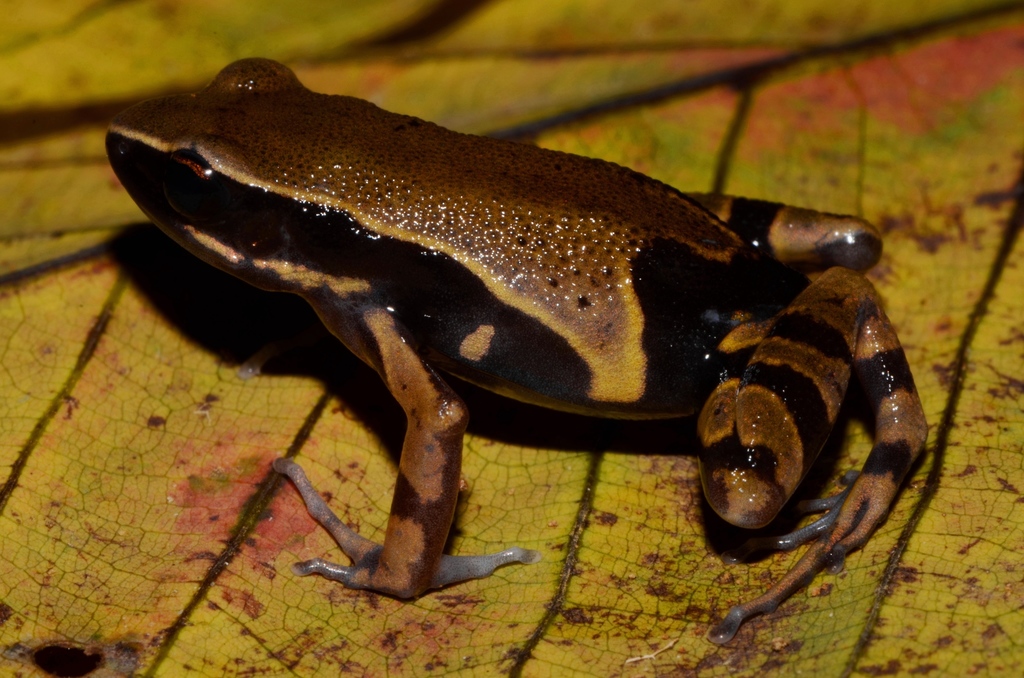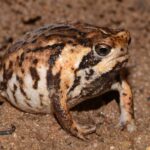- Introduction: A Hidden Jewel in Cameroon's Highlands
- Taxonomy and Classification: Understanding Cardioglossa alsco
- Natural Habitat: Life Among the Misty African Canopies
- Physical Characteristics: Delicate Beauty in Camouflage
- Behavior and Life Cycle: A Nighttime Ballet of Survival
- Ecological Role: Guardians of Forest Balance
- Threats and Conservation Status: Navigating an Uncertain Future
- Cultural and Scientific Significance: Frogs as Forest Ambassadors
- Conclusion: Preserving a Tiny Forest Treasure
Introduction: A Hidden Jewel in Cameroon’s Highlands#
Kelvin, an enthusiastic amphibian researcher, slowly parts leaves cloaked in dew in a thick mist-covered forest in southwestern Cameroon. His headlamp catches something small and ghostly pale on a fern leaf—a flash of black markings appearing under the subtle silver shine of his beam. Breathing deeply, he carefully reaches forward. In his palm sits Cardioglossa alsco, a delicate frog species so subtle yet stunning that every sighting offers a momentary revelation of nature’s quiet artistry.
First described scientifically in 2008 by Blackburn and colleagues, the Cardioglossa alsco—commonly known as the Alsco Long-fingered Frog—is a fascinating member of the Arthroleptidae family. Found exclusively in high-elevation rainforests of Cameroon, it plays a unique but often overlooked role in its ecosystem. Its distinctively elongated fingers and captivating markings make it a standout among Central African amphibians, yet its secretive lifecycle means sightings remain infrequent, turning each encounter into a valuable biological gem.
Taxonomy and Classification: Understanding Cardioglossa alsco#
Belonging to the Arthroleptidae family, Cardioglossa alsco is part of a fascinating genus of frogs known particularly for their slender forms and elongated digits. This genus, Cardioglossa—which translating from Latin means “heart-tongue,” in reference to their uniquely shaped tongues—is composed of several species, each subtly adapted to their unique corner of Africa’s dense forests.
Closely related species include Cardioglossa elegans and Cardioglossa melanogaster, sharing similar ecological roles and physical attributes. However, genetic assessments and subtle morphological distinctions, particularly the detailed patterning of dark spots set against pale or silvery skin, mark Cardioglossa alsco as distinct. Due to such striking characteristics, the Alsco Long-fingered Frog has become something of an icon among amphibian specialists and conservationists alike.
Natural Habitat: Life Among the Misty African Canopies#
The enchanting forests of southwestern Cameroon offer the sole known sanctuary for Cardioglossa alsco. Specifically inhabiting mountainous regions between elevations of approximately 1,600 to 2,000 meters above sea level, these frogs thrive in the mist-shrouded montane rainforests of the Rumpi Hills and adjacent highland areas.
A vivid tapestry of dense vegetation, shady undergrowth, and cascading water streams characterize their preferred habitat. Thick moss drapes tree branches, and foliage is soaked in near-constant mist, providing the moisture-rich environment essential to their sensitive amphibian skin. Hidden among leaf litter or perched quietly on broad leaves near trickling streams, the Alsco Long-fingered Frog finds an ideal microhabitat where moisture, temperature, and vegetation converge in perfect harmony.
These high-altitude forests are biodiversity hotspots hosting numerous endemic wildlife species, making habitats like these critical zones worthy of conservation priority. Cardioglossa alsco exists as both a symbol and barometer of ecological health, thriving only in stable, minimally disturbed forest ecosystems.
Physical Characteristics: Delicate Beauty in Camouflage#
At first glance, Cardioglossa alsco captivates observers instantly. Measuring about 25 to 30 millimeters, it’s a relatively small frog, its slight frame concealing surprisingly intricate adaptations. Its coloration—a blend of silvery-gray, creamy, and pale brown hues—offers perfect camouflage amidst its misty habitat’s dappled light and shadowy leaves.
The striking black markings scattered alongside its pale skin further enhance its cryptic appearance, mimicking droplets of water or shadowed leaf patterns. Its elongated fingers, characteristic of the genus, provide an impeccable grip, enabling stability on moist foliage and branches. Prominent eyes, large relative to its head size, enable excellent night vision, an essential trait for a nocturnal hunter navigating the crowded forest understory.
Thin and agile limbs allow effortless leaps from leaf to leaf and swift navigation of densely vegetated terrain. Its appearance, unique yet subtly beautiful, is perfectly tailored for stealth, agility, and survival in the moist forest realms it comfortably calls home.
Behavior and Life Cycle: A Nighttime Ballet of Survival#
Feeding Habits and Foraging Strategies#
As twilight blankets the forest, Cardioglossa alsco embarks on its nightly hunt. An opportunistic insectivore, it patiently awaits prey, primarily small insects and arthropods such as ants, beetles, and spiders, ambushing or intercepting them skillfully. Quick reflexes combined with its excellent vision ensure efficient predatory accuracy, essential for survival in a habitat where competitive pressures are intense.
Reproduction and Parental Care#
The breeding calls of male Cardioglossa alsco echo gently through the highland forests during rainy evenings, their soft, repetitive whistles blending seamlessly with the forest symphony. Unlike many frogs that seek larger bodies of water, Cardioglossa frogs prefer laying their eggs in small, secluded pools, slow-moving streams, or damp leaf litter sheltered beneath vegetation. Males are territorial yet inconspicuous—stationed strategically in prime locations where females are enticed to deposit eggs after careful selection.
Egg clusters, small translucent spheres housing developing embryos, carefully shelter tadpoles until they hatch. Soon after hatching, tadpoles seek sanctuary in gentle streams, pools, or stagnant trickles, feeding primarily on algae and microbial detritus. Their metamorphosis into adults coincides with seasonal trends in rainfall, ensuring optimal environmental conditions as they take on terrestrial life.
Ecological Role: Guardians of Forest Balance#
Though often unnoticed, Cardioglossa alsco plays a crucial ecological role. As a predator of insects, it actively controls insect populations, keeping ecological balance in check while indirectly benefiting plant diversity. Furthermore, the frog’s sensitivity to habitat changes makes it an excellent bioindicator species, warning researchers of potential ecosystem degradation long before it becomes visible through other ecological observations.
Its presence also supports larger predators within the local food web, such as birds, small mammals, and snakes. In this complex, intertwined network, the Alsco Long-fingered Frog is both predator and prey, symbolizing ecological balance and emphasizing the intricate interdependencies governing rainforest ecosystems.
Threats and Conservation Status: Navigating an Uncertain Future#
Experts worry deeply about Cardioglossa alsco populations due to ongoing threats—particularly habitat destruction from agricultural encroachment, logging operations, infrastructural developments, and climate change-induced forest drying patterns. These factors chip away at its essential habitat, fragmenting populations and potentially limiting genetic diversity and adaptive resilience.
Furthermore, heightened human activity is introducing various forms of pollution and pathogens—including diseases such as chytridiomycosis, a deadly fungus affecting amphibians worldwide—into previously pristine environments. Although scientific research on its exact population numbers remains limited, these pressures undoubtedly place Cardioglossa alsco at considerable risk.
Currently listed by the International Union for Conservation of Nature (IUCN) as Vulnerable, targeted conservation actions, habitat protection measures, and increased research focus are critical. Collaborative conservation initiatives between local communities, researchers, conservation organizations, and policymakers become pivotal to safeguard its future survival.
Cultural and Scientific Significance: Frogs as Forest Ambassadors#
While not featured prominently in local folklore compared with larger, more conspicuous wildlife, frogs like Cardioglossa alsco still influence Indigenous knowledge systems, often symbolizing fertility, renewal, and ecological vitality. Scientifically, its discovery has enriched ecological understanding of Cameroon’s biodiversity hotspots, attracting researchers worldwide eager to study endemic amphibian communities, adaptive evolution, species interactions, and climate change impacts.
Each discovery related to Cardioglossa alsco deepens humanity’s collective understanding of ecological balance, health indicators within forests, adaptive evolution strategies in amphibians, and the urgency of protecting fragile forest ecosystems.
Conclusion: Preserving a Tiny Forest Treasure#
Though small in stature, Cardioglossa alsco plays an outsized role within its ecological community and scientific context. A stunning creature adapted immaculately to the misty Cameroonian highlands, each sighting reminds observers of the intricate beauty and fragile magnificence sustaining our planet’s biodiversity.
Protecting the Alsco Long-fingered Frog isn’t merely about preserving a single species; it’s about maintaining the web of relationships that sustain entire forest ecosystems. As advocates, naturalists, or simply curious citizens drawn to nature’s wonders, we must remember species like Cardioglossa alsco could provide clues crucial to understanding ecological health as well as enriching human experience through their subtle, graceful existence.
Let your voice become an ally for amphibians—learn more, support local conservation projects, and cherish moments exploring and protecting these hidden jewels of the forest.












